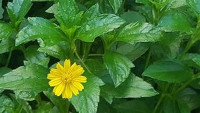Cytotoxicity Testing of Gold Nanoparticles from the Aqueous Extracts of Sphagneticola trilobata (L.) J.F Pruski on Shrimp Leach and Vero Cell line http://www.doi.org/10.26538/tjnpr/v7i12.42
Main Article Content
Abstract
Nanotechnology in the field of biomedicine has developed rapidly in recent years. However, concerns about their safety as pharmaceutical agents prevent their widespread application. In this study, the toxicity properties were assessed for a gold nanoparticle product produced using Sphagneticola trilobata (L.) J.F. Pruski aqueous flowers and leaves extracts as a bio-reductor (AuNP-AFSt and AuNP-ALSt, respectively). Brine shrimp lethality (BSL) and Methythiazol-2-yl-2,5-diphenyl tetrazolium bromide (MTT) were used for the cytotoxic assay. Toxicity on Artemia saline Leach and Vero cells were stated as Lethal Concentration (LC50) and Inhibitory Concentration (IC50), respectively. The findings showed that the LC50 values for AuNP-AFSt and AuNP-ALSt were 86.69 and 63.31 μg/mL. Additionally, the IC50 for AuNP-AFSt and AuNP-ALSt were discovered at concentrations of 30.80 μg/mL and 5.09 μg/mL. These results indicated that AuNP-AFSt and AuNP-ALSt were toxic on Shrimp leach (Meyer’s criteria), with moderate and highly toxic on Vero cells culture (NCI criteria).
Downloads
Article Details

This work is licensed under a Creative Commons Attribution-NonCommercial-NoDerivatives 4.0 International License.
References
Sim S, Wong NK. Nanotechnology and its use in imaging and drug delivery (Review)”. Biomed Rep. 2021; 14(5): 42.
Mitchell MJ, Billingsley MM, Haley RM, Wechsler ME, Peppas NA, Langer R. Engineering precision nanoparticles for drug delivery. Nat Rev Drug Discov. 2021; 20(2): 101-124. doi:10.15835/nbha43210049
Al-Saidi MH, Hadi WH. The green method of preparing nanoparticles and its applications in the field of biology; review. Mag Al-Kufa Univ boil. 2022; 14(2):43-62.
Rather M, Pandian J, Sundarapandian SM, Yogamoorthi A. Biosynthesis and characterization of silver nanoparticles using leaf extract of Wedelia urticifolia (Blume) DC and evaluation of antibacterial efficacy. IOSR J. Pharm. Biol. Sci. 2017; 12(4):14-23. doi:10.9790/3008-1204051423
Ying S, Guan Z, Ofoegbu PC, Clubb P, Rico C, He F, Hong J. Green synthesis of nanoparticles: Current developments and limitations. Environ. Technol. Innov. 2022; 26 (102336).
Muniyappan M, Pandeeswaran, Amalraj A. Green synthesis of gold nanoparticles using Curcuma pseudomontana isolated curcumin: Its characterization, antimicrobial, antioxidant and anti-inflammatory activities. Environ. Chem. Ecotoxicol. 2021; 3: 117-124. doi:10.1016/j.eti.2022.102336
Amina SJ, Guo B. A Review on the synthesis and functionalization of gold nanoparticles as a drug delivery vehicle. Int J Nanomedicine. 2020; 15: 9823-9857. doi:10.2147/IJN.S279094
Hammami I, Alabdallah NM. Gold nanoparticles: Synthesis properties and applications. J. King Saud Univ. Sci. 2022; 33: 101560. doi:10.1016/j.jksus.2021.101560
Aljohani FS, Hamed MT, Bakr BA, Shahin YH, Abu-Serie MM, Awaad AK, El-Kady H, Elwakil BH. In vivo bio‐distribution and acute toxicity evaluation of greenly synthesized ultra‐small gold nanoparticles with different biological activities. Sci Rep. 2022; 12(6269). doi:10.1038/s41598-022-10251-7
Santhosh PB, Genova J, Chamati H. Green synthesis of gold nanoparticles: An eco-friendly approach. Chemistry. 2022; 4(2):345-369. doi:10.3390/chemistry4020026
Aljabali AAA, Akkam Y, Al Zoubi MS, Al-Batayneh KM, Al-Trad B, Abo AO, Alkilany AM, Benamara M, Evans DJ. Synthesis of gold nanoparticles using leaf extract of Ziziphus zizyphus and their Antimicrobial Activity. Nanomaterials (Basel). 2018; 8(3):1-15. doi:10.3390/nano8030174
Ibikunle JB, Adebayo EA, Oke AM, Badmus JA, Yekeen TA, Kehinde DB. Anti-diabetic potential of silver (AgNPs) and gold (AuNPs) nanoparticles synthesized using an aqueous extract of Opuntia ficus-indica cladodes in Wistar Rats. Trop. J. Nat. Prod. Res. 2022; 6(7):1152-1158. doi:10.26538/tjnpr/v6i7.19
Mardina V, Ilyas S, Harmawan T, Halimatussakdiah H, Tanjung M. Antioxidant and cytotoxic activities of the ethyl acetate extract of Sphagneticola trilobata (L.) J.F. Pruski on MCF-7 breast cancer cell. J. Adv. Pharm. Technol. Res. 2020; 11(3): 123-127.doi: 10.4103/japtr.JAPTR_31_20
Mardina V, Ilyas S, Halimatussakdiah H, Harmawan T, Tanjung M, Yusof F. Anticancer, antioxidant, and antibacterial activities of the methanolic extract from Sphagneticola trilobata (L.) J. F Pruski leaves. J. Adv. Pharm. Technol. Res. 2021; 12(3): 222-226. doi: 10.4103/japtr.JAPTR_131_21
Das MP, Livingstone JR, Veluswamy P, Das J. Exploration of Wedelia chinensis leaf-assisted silver nanoparticles for antioxidant, antibacterial and in vitro cytotoxic applications. J. Food Drug Anal. 2018; 26(2): 917-925. doi: 10.1016/j.jfda.2017.07.014
Dey A, Yogamoorthy A, Sundarapandian SM. Green synthesis of gold nanoparticles and evaluation of its cytotoxic property against colon cancer cell Line. Res. J. Life Sci. Bioinformatics, Pharm. Chem. Sci. 2018; 4(6):1-17. doi:10.1016/j.eti.2022.10236
Boruah JS. Green synthesis of gold nanoparticles using an antiepileptic plant extract: in vitro biological and photocatalytic activities. RSC Adv. 2021; 11(45): 28029-28041. doi: 10.1039/d1ra02669k
Debnath SL, Kundu P, Golder M, Biswas B, Sadh SK. Phytochemical characterization and evaluation of pharmacological activities of leaves of a mangrove plant species Aegiceras corniculatum (L.). Trop. J. Nat. Prod. Res. 2020; 4(9):516-522. doi:10.26538/tjnpr/v4i9.4
Fauziah F, Sari M, Harnelly E, Ismail YS, Fitri L. Toxicity test of rose periwinkle (Catharanthus roseus) leaves endophytic bacteria using Brine Shrimp Lethality Test (BSLT) method. Biodiversitas. 2022; 23(1): 171-177. doi:10.13057/biodiv/d230122
Niksic H, Becic F, Koric E, Gusic I, Omeragic E, Muratovic S, Miladinovic B, Duric K. Cytotoxicity screening of Thymus vulgaris L. essential oil in brine shrimp nauplii and cancer cell lines. Sci Rep. 2021; 11:1-9. doi:10.1038/s41598-021-92679-x
Lee K X, Kamyar S, Miyake M, Kuwano N, Bahiyah N, Eva S,Yew YP. Green synthesis of gold nanoparticles using aqueous extract of Garcinia mangostana fruit peels. J Nanomater. 2016, 2: 1-7. doi:10.1155/2016/8489094
Le VT, Ngu NNQ, Chau T.P., Nguyen TD, Nguyen VT, Nguyen TLH, Cao XT, Doan V. Silver and gold nanoparticles from Limnophila rugosa leaves: Biosynthesis, characterization, and catalytic activity in reduction of nitrophenols. J Nanomater; 2021:1-11. doi:10.1155/2021/5571663
Pirko Y. Eco-friendly synthesis of gold nanoparticles using Camellia sinensis Phytoextracts. Lett. Appl. Nano Bio Science. 2021; 10(3): 2515–2524. doi:10.33263/LIANBS103.2515254
Sarkar KK, Islam T, Mitra T, Aktar A, Raja IM, Khalil I, Aktaruzzaman M, Rahman MA. Evaluation of Pharmacological activities of fractionated extracts of Hoya parasitica Wall. leaves. Trop J Nat Prod Res. 2022; 5(10):1747-1754. doi:10.1155/2022/1331758
Meléndez-Villanueva MA, Morán-Santibañez K, Martínez-Sanmiguel JJ, Rangel-López R, Garza-Navarro MA, Rodríguez-Padilla C, Zarate-Triviño DG, Trejo-Ávila LM. Virucidal activity of gold nanoparticles synthesized by green chemistry using garlic extract. Viruses. 2019; 11(12): 1111. doi:10.3390/v11121111


